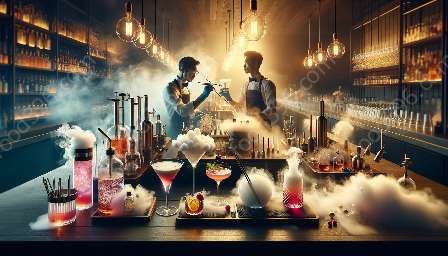Welcome to the exciting world of molecular mixology, where science meets art to create innovative and tantalizing cocktails. In this topic cluster, we will delve into the use of molecular ingredients in cocktails, understanding flavor pairing in molecular mixology, and how the science of molecular mixology is reshaping the way we experience cocktails.
Molecular Ingredients in Cocktails
Molecular mixology is a revolutionary approach to cocktail making that leverages scientific techniques and ingredients to enhance flavors, textures, and presentation. Molecular ingredients such as foams, gels, caviars, and aromatic airs are used to elevate traditional cocktail recipes to unprecedented levels of creativity and sensory delight.
One of the key aspects of molecular mixology is the use of hydrocolloids and emulsifiers. These molecular ingredients, derived from natural sources like seaweed and plants, are used to create unique textures and mouthfeel in cocktails. For example, the use of agar-agar can turn liquids into gels, while lecithin can be used to create foams and airs that add a playful element to the drinking experience.
In addition, molecular mixologists often incorporate spherification techniques, where liquid ingredients are encased in a thin gel membrane to create cocktail caviars. These tiny bursts of flavor provide an unexpected and delightful experience for the palate, adding a touch of molecular magic to the cocktail.
Flavor Pairing in Molecular Mixology
Flavor pairing in molecular mixology is a fascinating exploration of the chemical and sensory interactions between ingredients. By understanding the science behind flavor combinations, mixologists can create cocktails that harmoniously balance and enhance the flavors of each component, resulting in an extraordinary drinking experience.
One of the fundamental principles of flavor pairing in molecular mixology is the concept of aroma compounds. By analyzing the volatile compounds present in various ingredients, mixologists can identify complementary or contrasting aromas to create complex and intriguing flavor profiles in cocktails.
Another important aspect of flavor pairing is the use of sensory stimuli to evoke specific flavors and experiences. This can involve the use of visual, olfactory, and textural elements to heighten the perception of taste and aroma, creating multisensory cocktails that engage all of the senses.
The Art and Science of Molecular Mixology
Molecular mixology embodies the fusion of art and science, where creativity and innovation are guided by an understanding of molecular gastronomy, chemistry, and sensory perception. By embracing the principles of molecular mixology, bartenders and mixologists can push the boundaries of traditional cocktail making and offer guests a truly unique and memorable drinking experience.
From the meticulous preparation of molecular cocktails to the theatrical presentation at the bar, molecular mixology celebrates the craft of cocktail making as an immersive and interactive experience. By incorporating molecular ingredients and techniques, mixologists can craft cocktails that not only taste exceptional but also captivate the imagination and ignite curiosity.
As the world of mixology continues to evolve, the exploration of molecular ingredients in cocktails and the pursuit of the perfect flavor pairings will undoubtedly fuel a new wave of creativity and innovation behind the bar. Whether you're a seasoned mixologist or an aspiring cocktail enthusiast, the journey into the realm of molecular mixology is a thrilling and rewarding endeavor.

